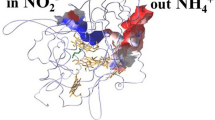Abstract
One of the principal mechanisms of nitrite inhibition of cellular respiration has been considered to be the interference with the action of iron-containing enzymes. In procaryotic systems, the effect of nitrite on cellular metabolism remains unclear. This study provides evidence which shows a direct inhibition by a low concentration of nitrite on a highly purified oxidase inPseudomonas aeruginosa. The inhibition pattern was observed and was consistent at cellular, electron-transport membranous, and enzymic (oxidase) levels. This implies that the mechanism of nitrite inhibition on bacterial respiration is due to a direct inhibition at the terminal site of oxygen reduction. The uncompetitive inhibition pattern shown by nitrite strongly suggested a mechanism quite different from those of classic cytochrome oxidase inhibitors such as cyanide, azide, and carbon monoxide.
Similar content being viewed by others
Literature Cited
Bard J, Townsend WE (1971) Meat curing. In: Price JF, Schweigert BS (eds) The science of meat and meat products. San Francisco: Freeman, pp 452–483.
Buchanan RL, Solberg M (1972) Interaction of sodium nitrite (sic) [nitrite], oxygen, and pH on growth ofStaphylococcus aureus J Food Sci 37:81–85
Castellani AG, Niven CF (1955) Factors affecting the bacteriostatic action of sodium nitrite. Appl. Microbiol 3:154–159
Commitee on Nitrite and Alternative Curing Agents in Food (1981) The health effects of nitrate, nitrite, and N-nitroso compounds. Part I. Washington DC: National Academy Press
Cuello C, Correa P, Haenzel W, Gordillo G, Brown C, Archer M, Tannenbaum S (1976) Gastric cancer in Colombia. I. Cancer risk and suspect environmental agents. J Natl Cancer Inst 57:1015–1020
Frankel AD, Duncan BK, Hartman PE (1980) Nitrous acid damage to duplex deoxyribonucleic acid: distinction between deamination of cystosine residues and a novel mutational lesion. J Bacteriol 142:335–338
Gornall AG, Bardawill CJ, David MM (1949) Determination of serum proteins by means of the biuret reaction. J Biol Chem 177:751–766
International Commission on Microbial Specifications for Foods (1980) Microbial ecology of foods, vol 2. New York: Academic Press, pp 323–998
Kerr RH, Marsh CT, Schroeder WF, Boyer EA (1926). The use of sodium nitrite in the curing of meat. J Agric Res 33:541–551
Lowry OH, Rosebrough NJ, Farr AL, Randall RJ (1951) Protein measurement with the Folin phenol reagent. J Biol Chem 193:265–275
Miller EC, Miller JA (1976) The metabolism of chemical carcinogens to reactive electrophiles and their possible mechanisms of action in carcinogenesis. In: Searle, CE (ed) Chemical Carcinogenesis, ACS monograph 173. Washington DC: American Chemical Society, pp 737–762
Mirvish SS (1971) Kinetics of nitrosamide formation from alkylureas,N-alkylurethans, and alkylguanidines: possible implication for the etiology of human gastric cancer. J Natl Cancer Inst 46:1183–1193
Mirvish SS, Bulay O, Runge RG, Patil K (1980) Study of the carcinogenicity of large doses of dimethylnitramine,N-nitroso-l-proline, and sodium nitrite administered in drinking water to rats. J Natl Cancer Inst 64:1435–1442
Reddy D, Lancaster JR, Cornforth DP 1983. Nitrite inhibition of clostridium botulinium: electron spin resonance detection of iron-nitric oxide complexes. Science 221:769–770
Rowe JJ, Yarborough JM, Rake JB, Eagon RG (1979) Nitrite inhibition of aerobic bacteria. Curr Microbiol 2:51–54
Tessman I (1959) Mutagenesis in phages OX174 and T4 and properties of the genetic material. Virology 9:375–385
Tompkin RB, Christiansen LN, Shaparis AB (1978) The effect of ion on botulinal inhibition in perishable canned cured meat. J Food Technol 13:521–527
Yang T (1982) Tetramethyl-p-phenylenediamine oxidase ofPseudomonas aeruginosa. Eur J Biochem 121:335–341
Yang T, Jurtshuk P (1978) Purification and characterization of cytochrome o fromAzotobacter vinelandii. Biochim Biophys Acta 502:543–548
Zimmerman FK (1977) Genetic effects of nitrous acid. Mutat Res 39:127–147
Author information
Authors and Affiliations
Rights and permissions
About this article
Cite this article
Yang, T. Mechanism of nitrite inhibition of cellular respiration inPseudomonas aeruginosa . Current Microbiology 12, 35–39 (1985). https://doi.org/10.1007/BF01567751
Issue Date:
DOI: https://doi.org/10.1007/BF01567751




